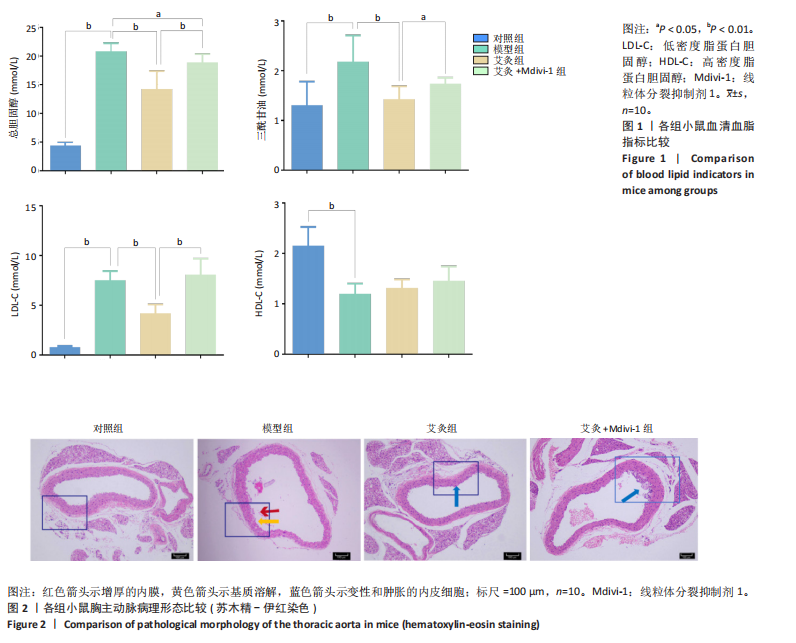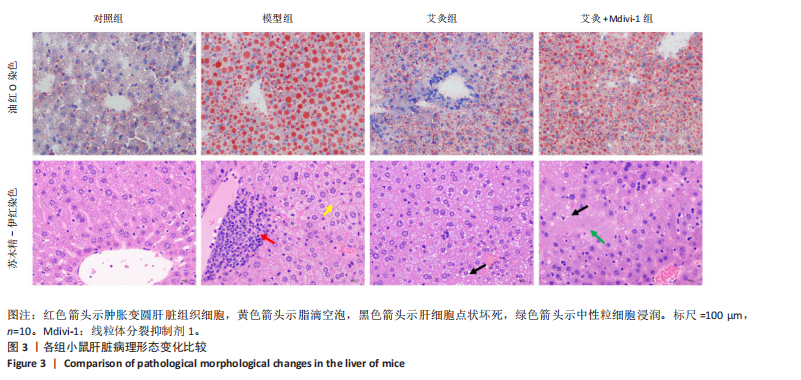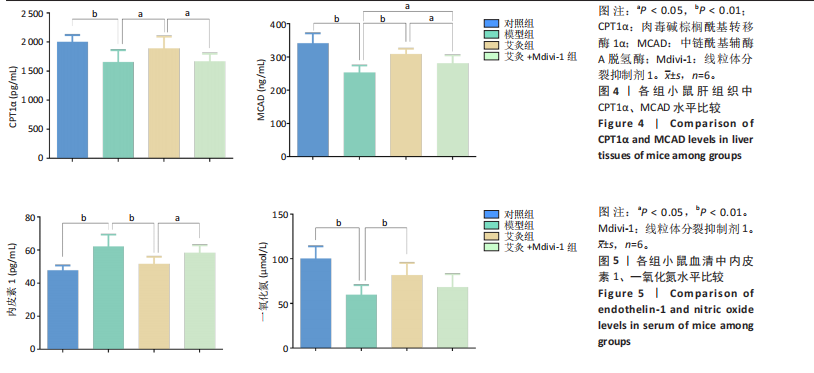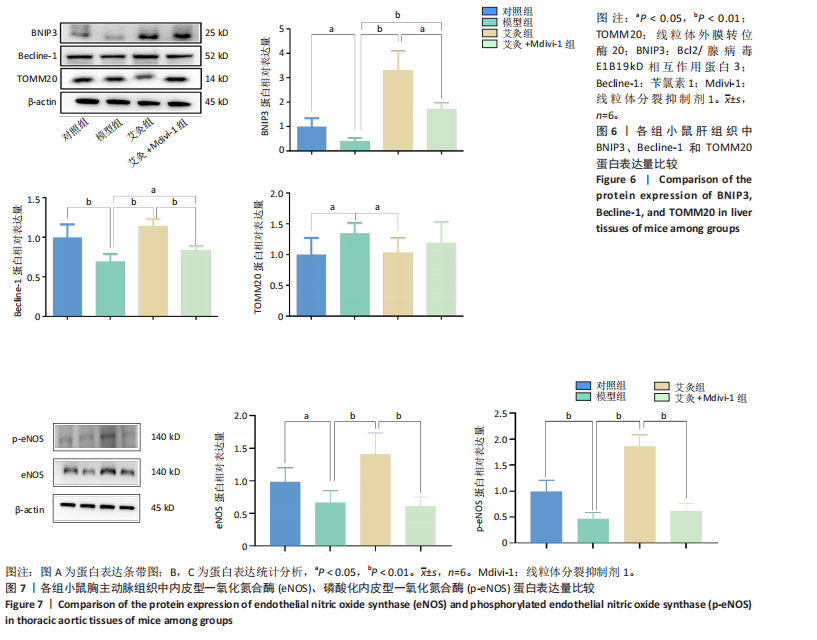[1] ZHU Y, XIAN X, WANG Z, et al. Research Progress on the Relationship between Atherosclerosis and Inflammation. Biomolecules. 2018; 8(3):80.
[2] DING Y, SUN Y, WANG H, et al.Atherosis-associated lnc_000048 activates PKR to enhance STAT1-mediated polarization of THP-1 macrophages to M1 phenotype. Neural Regen Res. 2024;19(11):2488-2498.
[3] YANG M, JIAO H, LI Y, et al. Guanmaitong Granule Attenuates Atherosclerosis by Inhibiting Inflammatory Immune Response in ApoE (-/-) Mice Fed High-Fat Diet. Drug Des Devel Ther. 2022;16:3145-3168.
[4] 徐倩, 姜志胜. 动脉粥样硬化机制研究的新认识[J]. 中国动脉硬化杂志, 2024,32(11):921-931.
[5] 刘姚钰菁, 沈月红, 瞿旻晔, 等. 从“脉生痰核”理论及脂质炎症学说辨治动脉粥样硬化[J]. 中药药理与临床, 网络首发时间:2024-06-13.
[6] 赵然, 赵文廷, 卢秉久. 基于“脾气散精”理论探讨线粒体功能紊乱对代谢相关脂肪性肝病的影响及机制[J]. 河北中医,2024, 46(6):1028-1032.
[7] 王伟霖, 王诗瑶, 王钰, 等. 基于NF-κB/p62通路探讨益脉颗粒调控动脉粥样硬化小鼠肝脏线粒体自噬与炎症的分子机制[J]. 辽宁中医药大学学报,2024,26(7):42-47.
[8] BARBIER-TORRES L, FORTNER KA, IRUZUBIETA P, et al. Silencing hepatic MCJ attenuates non-alcoholic fatty liver disease (NAFLD) by increasing mitochondrial fatty acid oxidation. Nat Commun. 2020;11(1):3360.
[9] 石情, 冉苏叶, 宋铃榆, 等. NLRP6过表达通过AMPK/CPT1A/PGC1A通路促进肝细胞脂肪氧化分解改善非酒精性脂肪肝[J]. 南方医科大学学报,2025,45(1):118-125.
[10] 肖怡琴. Zfp217通过脂肪酸氧化影响脂质代谢的研究[D]. 武汉:华中农业大学,2024.
[11] ZHANG L, YANG B, YU B. Paeoniflorin Protects against Nonalcoholic Fatty Liver Disease Induced by a High-Fat Diet in Mice. Biol Pharm Bull. 2015;38(7):1005-1011.
[12] YANG Y, OWUSU FB, WU H, et al. Mitochondria as therapeutic targets for Natural Products in the treatment of Cardiovascular Diseases. J Ethnopharmacol. 2025;345:119588.
[13] TIAN HY, YU DJ, XIE T, et al. Cordycepin alleviates metabolic dysfunction-associated liver disease by restoring mitochondrial homeostasis and reducing oxidative stress via Parkin-mediated mitophagy. Biochem Pharmacol. 2025;232:116750.
[14] 文晓宾. 羟基酪醇调控PI3K/Akt-Nrf2信号通路和线粒体自噬缓解仔猪肠道氧化损伤[D]. 北京:中国农业科学院, 2024.
[15] 余欣慧, 韩欣雨, 韩萌. 补肾安胎冲剂通过激活细胞自噬促进ox-LDL诱导PMVEC损伤模型血管生成的作用机制研究[J]. 中国中药杂志,网络首发时间:2025-04-10. doi: 10.19540/j.cnki.cjcmm.20250409.705
[16] 李金科, 杨凯凯, 杨善儒, 等. 血管老化机制的研究进展[J]. 中华老年心脑血管病杂志,2025,27(4):527-529.
[17] LU D, LI Y, NIU X, et al. STAT2/SLC27A3/PINK1-Mediated Mitophagy Remodeling Lipid Metabolism Contributes to Pazopanib Resistance in Clear Cell Renal Cell Carcinoma. Research (Wash D C). 2024;7:539.
[18] 王舒舒, 周桂庭, 林莉雯, 等. 脑心清介导AMPK/SIRT1通路促进脂肪酸氧化改善非酒精性脂肪肝[J]. 中药新药与临床药理,2024, 35(10):1531-1541.
[19] 郭向宇, 王浩, 杨戈. 延胡索乙素改善肝细胞脂质积累及氧化应激的作用机制[J]. 中国老年学杂志,2025,45(7):1712-1717.
[20] 闫朝勃, 伍先明, 张宁, 等. 艾灸对ApoE~(-/-)动脉粥样硬化小鼠SIRT1/FOXO3a信号通路的影响[J]. 针刺研究,2024,49(4):376-383.
[21] 吴冰心, 杨孝芳, 闫朝勃, 等. 温阳通脉灸法通过线粒体途径对ApoE-/-动脉粥样硬化小鼠内皮相关凋亡因子的影响[J]. 中华中医药学刊,网络首发时间:2025-04-21.
[22] 伍先明, 张宁, 朱洲, 等. 艾灸对ApoE-/-动脉粥样硬化小鼠沉默信息调节因子1/内皮型一氧化氮合酶信号通路的影响[J]. 针刺研究,网络首发时间:2025-02-12. doi: 10.13702/j.1000-0607.20240618
[23] 中国针灸学会.实验动物常用穴位名称与定位第3部分:小鼠[J]. 针刺研究,2021,46(5):445-446.
[24] 夏冉. 基于线粒体质量控制探究艾灸治疗气虚血瘀型慢性心力衰竭的机制及临床疗效观察[D]. 合肥:安徽中医药大学,2022.
[25] 王阶,李军,董艳,等.泛血管疾病的中医内涵及防治策略[J]. 中国实验方剂学杂志,2025,31(7):1-14.
[26] 安贺. PPP2CB通过LOX-1/MAPK/ERK轴促进动脉粥样硬化中的肝脂累积[D]. 十堰:湖北医药学院,2024.
[27] CUI Y, LIU J, HUANG C, et al. Moxibustion at CV4 alleviates atherosclerotic lesions through activation of the LXRalpha/ABCA1 pathway in apolipoprotein-E-deficient mice. Acupunct Med. 2019;37(4):237-243.
[28] KIAMEHR M, VIIRI LE, VIHERVAARA T, et al.Lipidomic profiling of patient-specific iPSC-derived hepatocyte-like cells. Dis Model Mech. 2017;10(9):1141-1153.
[29] 李超伟. 解偶联剂BAM15促进线粒体自噬改善动物肝脏脂肪代谢紊乱的机制研究[D]. 咸阳:西北农林科技大学, 2023.
[30] 杜敏, 陶丽宇, 冯骁腾, 等. 基于线粒体能量代谢障碍探讨从脾论治“双心疾病”的机制[J]. 北京中医药大学学报,2021,44(9):860-864.
[31] 张伟, 卢秉久, 张艳. 基于“肝心同病”探析代谢相关脂肪性肝病合并动脉粥样硬化的病机与治疗思路[J]. 北京中医药大学学报, 2023,46(5):697-704.
[32] 潘萌, 史晓燕. 线粒体自噬在肝脏相关疾病发生发展中的作用[J]. 临床肝胆病杂志,2024,40(2):413-418.
[33] 任甜甜, 刘如秀, 李翠芝, 等. 基于“虚气留滞”与线粒体自噬探讨慢性心力衰竭的病机与治疗[J]. 中医学报,2025,40(4):728-734.
[34] 郑标, 王琼, 肖玉波, 等. 线粒体自噬在动脉粥样硬化中作用的研究进展[J]. 中国病理生理杂志,2025,41(3):585-592.
[35] 何炜, 李玉明, 周欣, 等. 短时高强度间歇运动训练心肌梗死模型大鼠心室重构及线粒体变化[J]. 中国组织工程研究,2016,20(40): 5986-5993.
[36] 吴昀紫, 郗博洲, 马亮亮, 等. 线粒体质量控制与肿瘤研究进展[J]. 中国医学前沿杂志(电子版),2024,16(2):78-87.
[37] 张嘉祺, 王茜婷, 陈夏欢, 等. 线粒体融合分裂与自噬在动脉粥样硬化中的作用及研究进展[J]. 中华老年心脑血管病杂志,2024, 26(8):974-977.
[38] 宋明箫, 陈君顺子, 王宁伟, 等. 耐力训练大鼠抗动脉粥样硬化线粒体自噬通路中抗增殖蛋白2的作用[J].中国组织工程研究, 2025,29(11):2294-2300.
[39] 范靖琪. 调神针法调控线粒体自噬改善APP/PS1小鼠认知功能的研究[D]. 广州:广州中医药大学,2023.
[40] BERTOLIN G, FERRANDO-MIGUEL R, JACOUPY M, et al. The TOMM machinery is a molecular switch in PINK1 and PARK2/PARKIN-dependent mitochondrial clearance. Autophagy. 2013;9(11):1801-1817.
[41] 丁烨, 魏佳乐, 熊阳. 线粒体自噬在乳腺癌发生发展中的作用及其调控机制[J]. 中国药理学与毒理学杂志,2024,38(7):533-541.
[42] AHMADPOUR ST, DESQUIRET-DUMAS V, YIKILMAZ U, et al.Doxorubicin-Induced Autophagolysosome Formation Is Partly Prevented by Mitochondrial ROS Elimination in DOX-Resistant Breast Cancer Cells. Int J Mol Sci. 2021;22(17):9283.
[43] 王天源, 王晓慧. 有氧运动对糖尿病大鼠PPARα信号通路的影响及其与PPARγ关系[J]. 中国应用生理学杂志,2020,36(4):312-317.
[44] WANG Y, VISCARRA J, KIM SJ, et al. Transcriptional regulation of hepatic lipogenesis. Nat Rev Mol Cell Biol. 2015;16(11):678-689.
[45] HOUTEN SM, VIOLANTE S, VENTURA FV, et al. The Biochemistry and Physiology of Mitochondrial Fatty Acid beta-Oxidation and Its Genetic Disorders. Annu Rev Physiol. 2016;78:23-44.
[46] 王爽. DGAT2/PLIN5介导脂肪肝奶牛肝细胞脂滴-线粒体互作调控脂肪酸代谢机制研究[D]. 大庆:黑龙江八一农垦大学,2024.
[47] 文佩华. 肝豆汤调控JAK2-STAT5通路及脂肪酸β氧化改善Wilson病模型肝脏脂肪变性的机制研究[D]. 安徽中医药大学,2024.
[48] BOUGHALEB H, LOBYSHEVA I, DEI ZF, et al. Biological Assessment of the NO-Dependent Endothelial Function. Molecules. 2022;27(22):7921.
[49] WU XM, ZHANG N, LI JS, et al. Purinergic receptors mediate endothelial dysfunction and participate in atherosclerosis. Purinergic Signal. 2023; 19(1):265-272.
[50] MOUNT PF, KEMP BE, POWER DA.Regulation of endothelial and myocardial NO synthesis by multi-site eNOS phosphorylation. J Mol Cell Cardiol. 2007;42(2):271-279.
[51] 刘冬, 王琨. 线粒体分裂抑制剂Mdivi-1通过抑制线粒体自噬促进炎症微环境下髓核细胞衰老退变的研究[J]. 现代医学,2022, 50(6):735-741.
|



